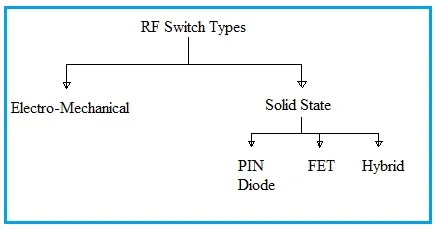

Guide to RF Switches
Catalog
What Are RF Switches?The Types of RF SwitchesMain Characteristics of RF Switches:Applications of RF SwitchesFrequently Asked QuestionsRelated ArticlesWhat Are RF Switches?
RF switches, or radio frequency switches, are electronic components that are mainly utilized to manage the propagation routes of radio frequency signals. They function as adjustable conduits within circuits, deciding whether to allow RF signals to travel along a certain route or to halt their transmission. These signals, which are a form of electromagnetic waves, have frequencies that range from 3kHz to 300GHz and are extensively used in diverse sectors such as wireless communications, radar systems, and broadcasting television.
Take mobile phones as an example: they often come equipped with several antennas capable of receiving and transmitting signals across a variety of frequency bands. RF switches can direct these RF signals to the most appropriate antenna or to the circuit path that matches the specific frequency band, considering factors like the network environment (such as 2G, 3G, 4G, or 5G) and the strength of the signal, thus facilitating optimal communication outcomes.
To put it succinctly, RF switches are electronic components operating in the radio frequency spectrum that are employed for selecting signal paths or for toggling signals on and off.


What Are RF Switches?
The Types of RF Switches
Mechanical RF Switches
Mechanical RF switches function through the physical manipulation of contact points. They employ a mechanical actuator to either establish or sever an electrically conductive pathway. For instance, a toggle-style mechanical RF switch features a lever that manually shifts a metal contact to create or terminate an electrical link.
These contacts are typically crafted from materials that exhibit excellent electrical conductivity, such as brass or gold-plated metals. When the contacts are bridged, the RF signal is permitted to traverse the switch; conversely, when the contacts are separated, the signal's trajectory is obstructed.
Solid-State RF Switches
Solid-state RF switches rely on semiconductor technology. The predominant varieties incorporate PIN diodes or field-effect transistors (FETs). PIN diodes modulate their resistance based on the bias voltage that is applied. With a forward bias, the PIN diode enters a low-resistance phase, permitting the RF signal to traverse. Conversely, under reverse bias, it adopts a high-resistance configuration, impeding signal propagation. FET-based solid-state RF switches regulate the conductivity along the channel between the source and drain terminals. By administering an appropriate gate voltage, the FET can alternate between a conductive on-state and a non-conductive off-state.
Relay-Based RF Switches
Relay-based RF switches harness the power of electromagnetic relays. When an electric current traverses the relay's coil, it produces a magnetic field that actuates the mechanical contact to either engage or disengage. The relay essentially serves as an electrically controlled switch. The contacts within a relay-based RF switch are engineered to manage RF signals, with the design intent being to reduce signal degradation and interference during the switching process.


The Types of RF Switches
Main Characteristics of RF Switches:
1.Operating Frequency Bands: RF switches are engineered to function across designated frequency bands, spanning from low frequencies to the millimeter-wave spectrum. The specific frequency band dictates the nature of signals that the switch is capable of managing.
2.Signal Attenuation in Operation: This refers to the reduction in signal strength when the switch is activated. A minimal level of signal attenuation is preferred as it signifies preservation of signal quality, which is essential for sustaining signal fidelity, particularly in applications with high data transfer rates.
3.Signal Separation: Signal separation denotes the switch's capacity to prevent signal transmission when it is deactivated. Optimal signal separation is vital for avoiding cross-path signal interference, which can lead to system performance degradation.
4.Signal Power Management: RF switches are required to manage the power intensity of the signals they direct without incurring substantial distortion or damage. This feature is especially significant in applications involving high-power signals.
5.State Transition Velocity: The rate at which an RF switch can toggle between states is a critical factor, particularly in systems that necessitate rapid signal routing or signal multiplexing.
6.Operational Linearity: It is essential for RF switches to function in a linear fashion to prevent signal distortion, which is of particular importance in systems where the integrity of the signal's form and magnitude is paramount.
7.Reflection and Transmission Efficiency: This metric, known as VSWR, reflects the switch's compatibility with the impedance of the attached transmission lines. A lower VSWR indicates superior matching, leading to reduced signal reflection and enhanced signal transmission efficacy.
8.Command Interface: RF switches can be directed through a variety of control methods, such as digital signal levels, analog voltages, or through software instructions in more sophisticated systems.


Main Characteristics of RF Switches
Applications of RF Switches
Telecommunications Sector
In the realm of telecommunications, RF switches are indispensable for directing and managing radio frequency signals across cellular networks, base stations, and overall communication infrastructure.
Aerospace and Defense Sector
RF switches see extensive use in aerospace and defense, covering applications such as radar systems, satellite communications, avionics, electronic warfare, and the operation of unmanned aerial vehicles (UAVs).
Automotive Sector
The automotive industry also incorporates RF switches in wireless communication systems, telematics, infotainment systems, and vehicle-to-everything (V2X) communications.
Medical Sector
RF switches are utilized in medical equipment and devices, including MRI machines, surgical instruments, wireless monitoring systems, and telemedicine. Notably, in MRI machines, RF switches can manage high power levels and offer highly dense switching configurations, potentially revolutionizing medical treatments in MRI, ultrasound, and other advancing medical device technologies.
Industrial and Manufacturing Sector
RF switches are deployed in a variety of industrial and manufacturing processes, encompassing industrial automation, robotics, wireless sensing, and machine-to-machine (M2M) communication.
Satellite Communication Systems
RF switches are instrumental in satellite communication systems for selecting appropriate antennas based on varying transmission needs and environmental conditions. Their low drive voltage and minimal power consumption substantially enhance the battery life of communication equipment, which is vital for enduring space missions and the prolongation of satellite service life.


Applications of RF Switches
Frequently Asked Questions
1. Function of an RF Switch
An RF switch, or microwave switch, is a device that directs high-frequency signals along specific transmission paths. These switches are extensively utilized in microwave test systems for routing signals between testing instruments and the devices under test (DUT).
2. Applications of RF Switches
RF switches are commonly employed for selecting bands and switching frequency signals across various RF input/output interfaces. These components are essential for maintaining signal quality and strength across a range of applications.
3. Parameters of an RF Switch
Regardless of the RF technology in use, the performance of these switches is defined by four key electrical parameters: isolation, insertion loss, switching speed, and power capacity.
4. Use of RF Devices
Radiofrequency (RF) devices are frequently utilized in aesthetic medicine. They are employed for skin tightening, stimulating collagen production, body contouring by heating and eliminating fat cells, and facial rejuvenation. These devices can treat larger areas like the abdomen or flanks in a relatively short amount of time.
5. Maximum Range of RF
Radio frequency (RF) refers to the oscillation rate of alternating electric currents or voltages, or of magnetic, electric, or electromagnetic fields, within a frequency range from approximately 20 kHz to around 300 GHz.
6. Uses of RF
RF is primarily used in three areas: transmitting information over long distances wirelessly, such as in TV and radio broadcasting, satellite communications, mobile phones, and Wi-Fi; sensing and detecting objects with technologies like radar and airport body scanners; and heating objects in microwave ovens or in industrial settings.
7. Advantages of RF
Radio frequency devices use safe levels of low-frequency electromagnetic waves to generate heat, which penetrates deep into the skin's layers, stimulating the production of new skin cells (regeneration) and the synthesis of collagen and elastin.
8. Purpose of an RF Transformer
RF transformers serve a broad spectrum of applications due to their versatile configurations, which can fulfill various functions. These include, but are not limited to, injecting DC current, providing DC isolation between circuits, and improving common mode rejection.
Related Articles
The Difference Between Linear and Tactile Switches
Subscribe to JMBom Electronics !













